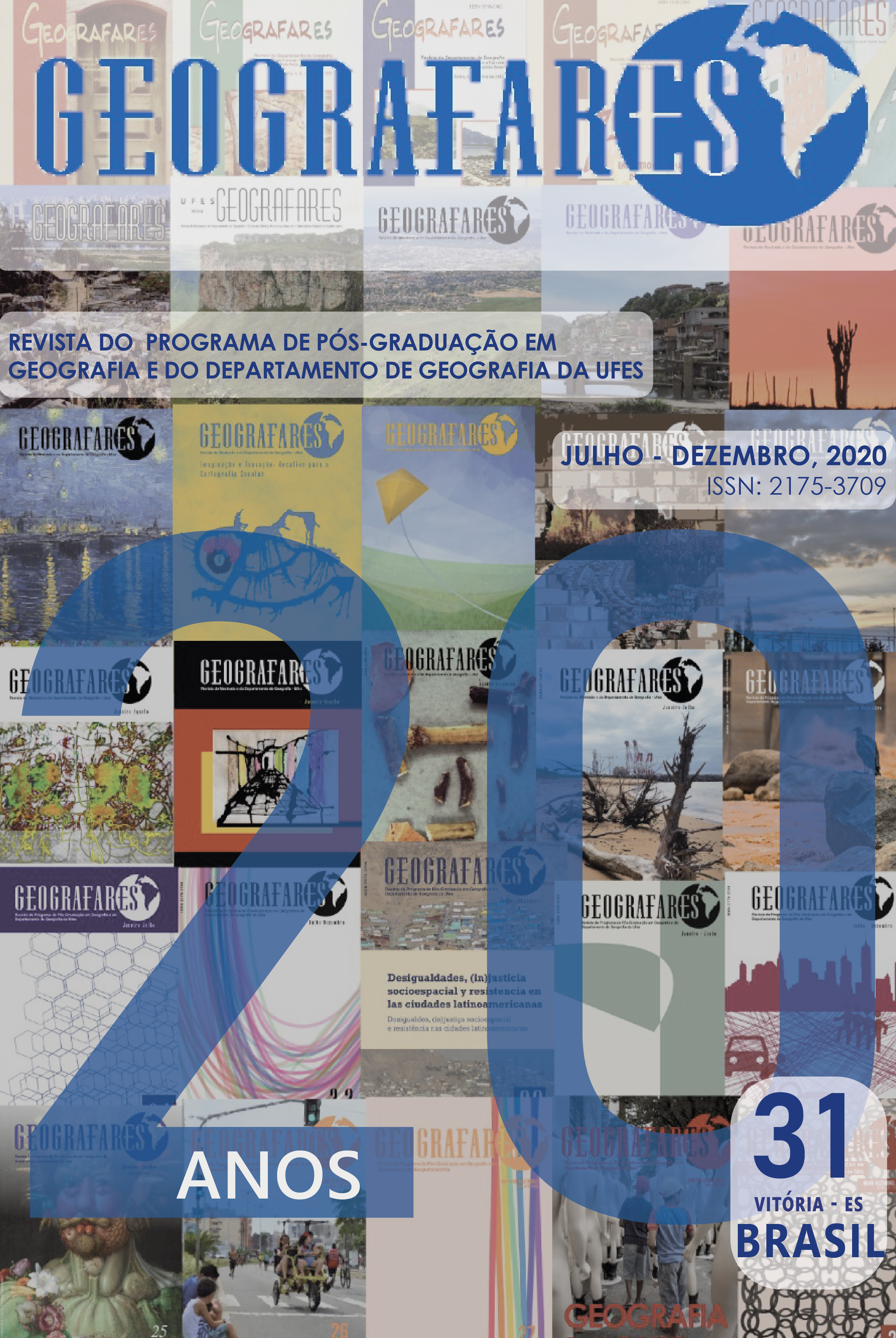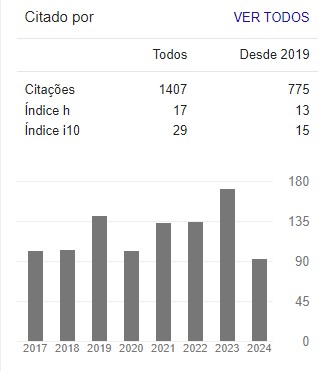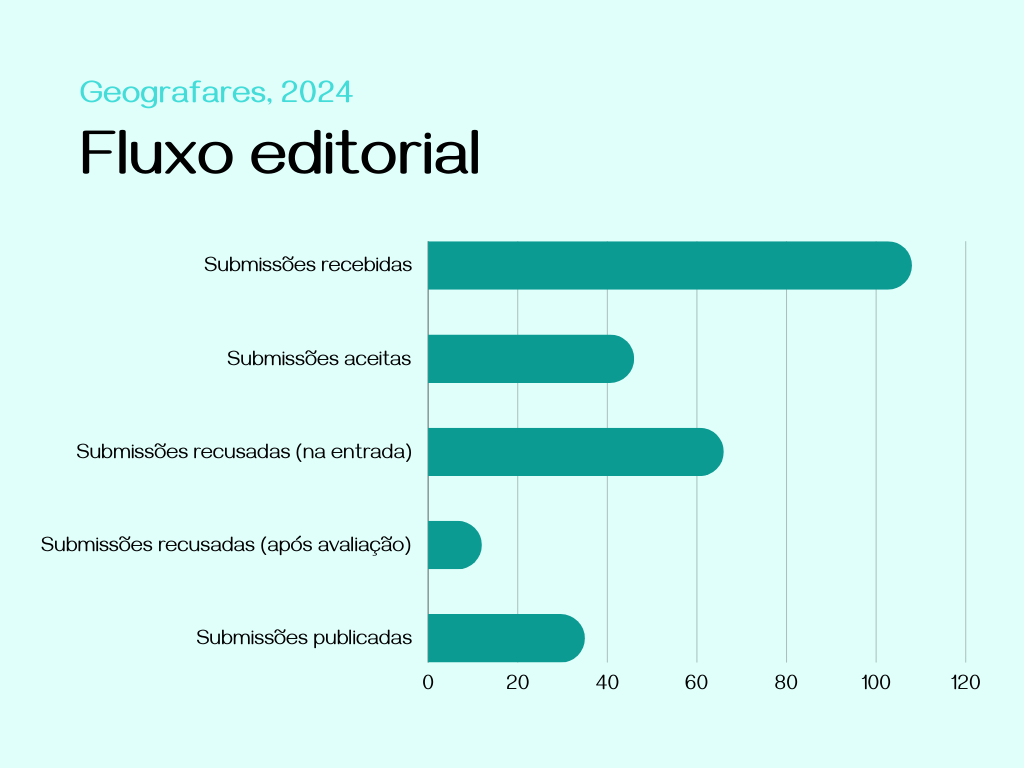Complejidad de la bien vida
Pesaje basado en las nociones de calidad de vida, salud, bienestar, felicidad y sostenibilidad
DOI:
https://doi.org/10.7147/geo.v1i31.30883Palabras clave:
Necesidades. Valores. Multidimensionalidad de la vida.Resumen
El propósito de este artículo es analizar las nociones de calidad de vida, bienestar, felicidad, salud y sostenibilidad para identificar las asociaciones entre ellas. Por tanto, los discute de forma teórico-conceptual, así como busca contextualizarlos empíricamente, de forma objetiva y subjetiva, en Uberlândia-MG. Para lograr el objetivo, se combina una revisión bibliográfica con análisis de datos primarios y secundarios. Se señala que a pesar de las relaciones intrínsecas y algunas superposiciones entre tales nociones, difieren. La sustentabilidad presupone un entendimiento colectivo y, como la salud, es fundamental en la dimensión objetiva, pero no solo en esta, dada su fuerte interrelación con la calidad de vida. Para la felicidad y la calidad de vida, destaca la dimensión, que presupone la comprensión desde la escala individual.
Descargas
Citas
BATISTELLA, C. Abordagens contemporâneas do conceito de saúde. In: Fonseca, Angélica Ferreira (Org.) O território e o processo saúde-doença. Rio de Janeiro: EPSJV/Fiocruz, 2007, p.51 a 86.
BERGER-SCHMITT, R.; NOLL, H.-H.. Conceptual Framework and Structure of a European System of Social Indicators. UE Reporting Working Paper, n. 9, Mannheim: Centre for Survey Research and Methodology (ZUMA). 2000.
BERRY, B. J. L.; BAKER A. M. Amostragem Geográfica (Geographic Sampling in Spatial Analysis, In: Statistical Geography, Prentice Hall, Inc., Englewood Cliffs, New Jersey, 1968. p. 91-100.
BOOZ-ALLEN PUBLIC ADMISTRATION SERVICES. The Quality of Life Concept: A Potential New Tool for Decision-Makers. Environmental Protection Agency, Washington, 1973. In: Social Indicators Research, JOHNSON D. L. (Review). v.1, n.3, p. 383-385, dec,1974.
BRASIL. Ministério da Saúde. Secretaria de Vigilância em Saúde. Política nacional de promoção da saúde / Ministério da Saúde, Secretaria de Atenção à Saúde. – Brasília: Ministério da Saúde, 2014.60 p. Série B. Textos Básicos de Saúde.
COMISSÃO EUROPEIA. Relatório cidades europeias sustentáveis. Grupo de Peritos sobre o Ambiente Urbano. Ambiente, Segurança Nuclear e Protecção Civil. Bruxelas, Mar. 1996.
CROCKER, D. Qualidade de Vida e Desenvolvimento: o enfoque normativo de Sen e Nussbaun. Lua Nova, São Paulo, n.31, p.99-133, 1993.
DODGE, R.et al. The challenge of defining wellbeing. International Journal of Wellbeing, v.2, n.3, p. 222-235, 2012.
FAHEY, T., et al. Monitoring quality of life in Europe. European Foundation for the Improvement of Living and Working Conditions. Luxembourg: Office for Official Publications of the European Communities, 2003.
FELCE, D.; PERRY, J. Quality of Life: Its Definition and Measurement. Research in Developmental Disabilities, v. 16, n.1, p. 51-74, 1995.
FENERI, A. M.; VAGIONA, D.; KARANIKOLAS, N. Measuring Quality of Life (QOL) in Urban Environment: An Integrated Approach. In: 13th International Conference on Environmental Science and Technology, CEST 2013, Athens, 5-7 September 2013.
HARDI, P.; PINTÉR L. Models and Methods of Measuring Sustainable Development Performance. Revised draft discussion paper prepared for the sustainable development coordination unit, executive council, government of Manitoba. International Institute for Sustainable Development Winnipeg, Manitoba Canada. 1995. Disponível em: <https://www.iisd.org/sites/default/files/pdf/measure_models_methods_sd.pdf. >. Acesso em: 24 mai. 2014.
HERCULANO, S. C. A qualidade de vida e seus indicadores. Ambiente e Sociedade. Ano I, n. 2, p 77 –99, 1998.
KAHNEMAN, D. et al. A survey method for characterizing daily life experience: The day reconstruction method. Science, v.306, v.5702, p.1776–1780, 2004.
KAMP, I. V; LEIDELMEIJER, G. M.; HOLLANDER, A. Urban environmental quality and human well-being: towards a conceptual framework and demarcation of concepts; a literature study. Landescape and Urban Planning, v.65, n.1, p. 5-18, 2003
LAMBIRI, D., et al. Quality of life in the economic and urban economic literature. Social Indicators Research, v.84, n.1, p. 1-25, 2006.
LORA, E. Calidad de vida más allá de los hechos., LORA, E. (org.). Banco Interamericano de Desarrollo: Fondo de Cultura Econômica, 2008.
MARANS, R. W.; STIMSON, R. J. Investigating Quality of Urban Life: Theory, Methods, and Empirical Research. Social Indicators Research Series, v. 45. Springer Dordrecht, Heidelberg, London, New York, 2011.
MCCREA, R. Urban quality of life: Linking objective dimensions and subjective evaluations of the urban environment. Unpublished PhD thesis, The University of Queensland, Brisbane. 2007.
MINAYO, M. C. S. Qualidade de vida e saúde como valor existencial. Ciência & Saúde Coletiva. v. 18, n. 7, p. 1868, 2013.
MINAYO, M. C. S.; HARTZ, Z. M. A. & BUSS, P. M. Qualidade de vida e saúde: um debate necessário. Ciência & Saúde Coletiva, v.5, n.1, p.7-18, 2000.
MORIN, E.; CIURANA, E. R.; MOTTA, R. D. Educar na era planetária: o pensamento complexo como método de aprendizagem pelo erro e incerteza humana. São Paulo: Cortez; Brasília, DF: UNESCO, 2007.
MRIDHA, A. M. M. H.; MOORE, G. T. The Quality of Life in Dhaka, Bangladesh: Neighborhood Quality as a Major Component of Residential Satisfaction. In: MARANS, R. W.; STIMSON, R. J. (Ed). Investigating Quality of Urban Life: Theory, Methods, and Empirical Research. Social Indicators Research Series,v.45. Springer Dordrecht, Heidelberg, London, New York, 2011. p. 251-272.
MONKEN, M.; BARCELLOS, C. Vigilância em saúde e território utilizado: perspectivas teóricas. Cadernos de Saúde Pública, v. 21. n.3, p. 898-906, maio.-jun, 2005.
NOGUEIRA, V. M. R. Bem-Estar, Bem-Estar Social ou Qualidade de Vida: a reconstrução de um Conceito. Semina: Ciências Humanas e Sociais, Londrina, v. 23, p. 107-122, set. 2002.
OECD. Organisation for Economic Co-operation and Development .Guidelines on Measuring SubjectiveWell-being. 2013. Disponível em: <http://dx.doi.org/10.1787/9789264191655-en>Acesso em: 20 jan. 2014.
PARTIDÁRIO, M. do R. Indicadores de Qualidade de Ambiente Urbano. Lisboa, Direcção Geral de Ordenamento do Território e Desenvolvimento Urbano, Colecção Estudos 4, 2000, 155 p.
PAIS-RIBEIRO, J. A importância da qualidade de vida para a psicologia da saúde. In: CRUZ, J.P., et al. (Coords.). Bem-Estar e Qualidade de vida. Alcochete: Textiverso, 2009, p.31-49.
RIGHETTI, S. Condições ambientais e bem estar social são fatores que influenciam saúde da população. Cienc. Cult. v.56, n.2, p. 06-07, 2004.
RUTLEDGE, R. B.; et al. A computational and neural model of momentary subjective well-being. University of Cambridge, Cambridge, United Kingdom, Proceedings of the National Academy of Sciences-PNAS, v. 111, n. 33, p.12252–12257, August 19, 2014. Disponível em:<http://www.pnas.org/content/111/33/12252.full>. Acesso em: 20 mai. 2015.
SABROZA, P. C. Concepções de Saúde e Doença. Rio de Janeiro: EAD, Ensp, 2001. (Texto de Apoio ao módulo I do Curso de Especialização em Gestão de Sistemas e Serviços de Saúde).
SEN, A. O desenvolvimento como expansão de capacidades. Lua Nova no.28-29 São Paulo Abr. 1993.
STIGLITZ, J. E.; SEN, A; FITOUSSI, J-P. Mis-measuring our lives: why GDP doesn’t add up. New York: The New Press, 2010.
STIMSON, R., et al. The Brisbane-South East Queensland Region, Australia: Subjective Assessment of Quality of Urban Life and Changes over Time. In: MARANS, R. W.; STIMSON, R. J. (Ed). Investigating Quality of Urban Life: Theory, Methods, and Empirical Research. Social Indicators Research Series, v.45. Springer Dordrecht, Heidelberg, London, New York, 2011, p.185-208.
UN- United Nations. Inequality of what? Inequality between whom? Humanity Divided: Confronting Inequality in Developing Countries, 2013, 40p. Disponível em: <http://www.undp.org/content/dam/undp/library/Poverty%20Reduction/Inclusive%20development/Humanity%20Divided/HumanityDivided_Ch1_low.pdf>. Acesso em: 14 fev. 2014.
WHO. World Health Organization. Constitution of the World Health Organization. 1946. Disponível em: < https://www.who.int/governance/eb/who_constitution_en.pdf >. Acesso em: 17 mai. 2020.
______ WHOQOL Group. Development of the WHOQOL: Rationale and current Status. In Int. J. Ment. Health. v. 23, n.3, p.24-56, 1994.
______. The WHOQOL Group. The World Health Organization Quality of Life assessment (WHOQOL): position paper from the World Health Organization. Soc Sci Med. v.41, n.10, p.1403-9, 1995.
_____. Regional Office for Europe. Measurement of and target- setting for well-being: an initiative by the WHO Regional Office for Europe, 2012.
_____.The European health report 2015: Targets and beyond – reaching new frontiers in evidence. Disponível em: < http://www.euro.who.int/en/data-and-evidence/european-health-report/european-health-report-2015>. Acesso em: 15 nov. 2015.
Descargas
Publicado
Cómo citar
Número
Sección
Licencia
Autores que publicam nesta revista concordam com os seguintes termos:- Autores mantém os direitos autorais e concedem à revista o direito de primeira publicação, com o trabalho simultaneamente licenciado sob a Licença Creative Commons Attribution que permite o compartilhamento do trabalho com reconhecimento da autoria e publicação inicial nesta revista.
- Autores têm autorização para assumir contratos adicionais separadamente, para distribuição não-exclusiva da versão do trabalho publicada nesta revista (ex.: publicar em repositório institucional ou como capítulo de livro), com reconhecimento de autoria e publicação inicial nesta revista.
- Autores têm permissão e são estimulados a publicar e distribuir seu trabalho online (ex.: em repositórios institucionais ou na sua página pessoal) (Veja O Efeito do Acesso Livre).



























